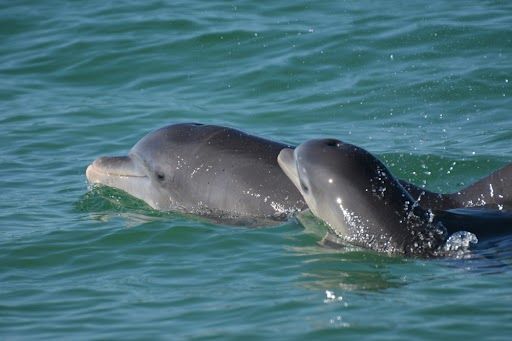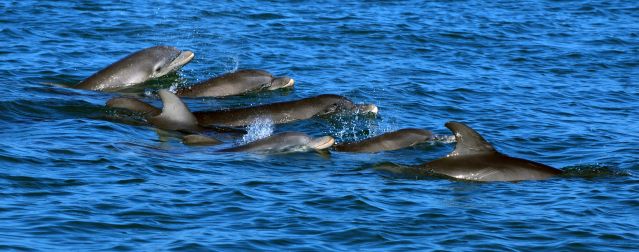Animal Behavior
Dolphins Talk in “Motherese” to Their Calves
Like humans, dolphins change their vocalizations when addressing offspring.
Posted June 27, 2023 Reviewed by Abigail Fagan
Key points
- Adults modify their speech in ways that promote attention, bonding, and language acquisition in children.
- This is termed "motherese" or child-directed communication, and is rare in other species.
- In the presence of their calves, female dolphins change their whistles in ways that parallel human motherese.

Across human cultures, people modify their speech when interacting with children, typically using higher pitches and a wider range of pitches. It’s sometimes referred to as “motherese” or “baby talk,” though it is used by caregivers of both sexes and directed towards children as well as infants. A more inclusive term is child-directed communication, but even that may not be broad enough: new research suggests that bottlenose dolphins (Tursiops truncatus) similarly change their communication signals in the presence of their calves.
Marine Mammal Motherese
There is very little evidence for motherese in nonhuman animals. But dolphins seem to be a logical species to investigate.
In humans, the use of motherese is thought to promote attention, bonding, and language acquisition. Bottlenose dolphins also form long-term mother-offspring bonds and are capable of lifelong vocal learning. In addition, each dolphin produces a signature whistle, an individually distinctive vocalization used for recognition and maintaining contact with others. This means that researchers could measure changes in the same vocalizations produced in the presence or absence of calves.
An international team of researchers did just that, working with a community of wild dolphins near Sarasota Bay, Florida, which have been studied for more than 50 years. During brief catch-and-release health assessments, the researchers recorded the vocalizations (primarily signature whistles) of known individual dolphins. Then they compared subtle acoustic parameters of the whistles produced by the same females recorded with and without their dependent calves.
They found that mother dolphins consistently produced signature whistles with higher maximum frequencies and greater frequency ranges when they were with their calves than when they were alone or with unrelated dolphins, paralleling patterns seen in human motherese.
Functional Questions
Dolphins join an exclusive group of species that appear to use motherese. In addition to humans, it includes zebra finches, the males of which change acoustic parameters of their song in the presence of juveniles compared to when singing alone or to females.

Lead author Laela Sayigh, a marine biologist at Woods Hole Oceanographic Institute and associate professor at Hampshire College, says this is likely an example of convergent evolution.
“The fact that a similar type of communicative strategy evolved in such disparate groups—humans, zebra finches, and dolphins—suggests that it serves a function,” she says. “It’s been suggested that human motherese functions to enhance vocal learning and strengthen bonds, and these are highly relevant to dolphins, as well.”
However, Sayigh and colleagues emphasize that while the idea that motherese functions similarly in humans and dolphins makes sense, it is still speculation. There are other plausible explanations for the acoustic differences in mothers’ signature whistles that cannot be ruled out. In addition to promoting social bonds and vocal learning, motherese could help mothers target their offspring as recipients of their whistles or help calves identify calls meant for them. Conversely, it is also possible that the observed acoustic changes are simply byproducts of physiological changes associated with lactation or parenting and don’t serve any function at all. To really get to the function of motherese, Sayigh says, one would have to do a controlled experiment involving separating calves from their mothers, which is not ethically possible.
The More We Know
Even with the function or functions of dolphin motherese unknown, the findings have implications for the conservation of these marine mammals. The detection of these subtle changes in mothers’ signature whistles could help researchers monitor reproductive success and population health in wild dolphins, for instance.
The findings also raise more questions about how noise may impact dolphins’ ability to communicate. Small differences in the higher frequencies of their whistles are more likely to be masked by human-produced noise, such as that made by recreational boats, according to Sayigh.
“Dolphins are auditory animals,” she says. “Their primary experience of the world is through sound. The subtle frequency increases we see in mothers’ whistles directed at their calves may potentially become unintelligible in a lot of circumstances.”
Sayigh is eager to study these questions with practical, conservation applications. But she is also motivated by the desire to learn more about the behavior of an animal with fascinating, and sometimes familiar, behaviors.
“I feel that there's inherent value in understanding other species and getting a greater understanding of how they work and how they communicate with each other,” she says.
References
Sayigh LS, El Haddad N, Tyack PL, Janik VM, Wells RS, and Jensen FH. Bottlenose dolphin mothers modify signature whistles in the presence of their own calves. Proceedings of the National Academy of Sciences 120(0): 202300262. Doi: 10.1073/pnas.2300262120.


